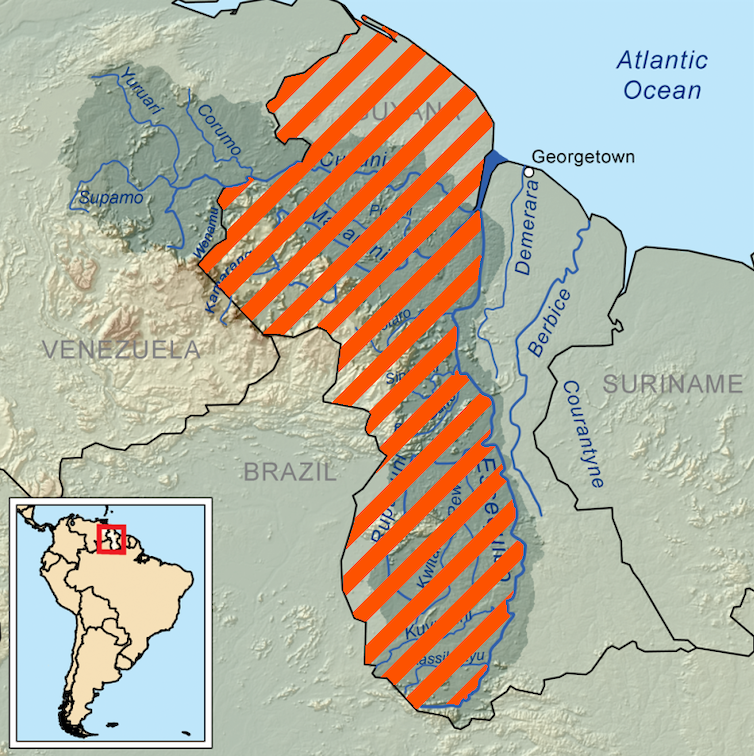The US air force has taken the unusual step of holding joint drills with Guyana as the United Nations scheduled an emergency meeting of the security council to discuss Venezuela’s threat to annex more than two-thirds of the oil-rich South American country.
Guyanese president, Irfaan Ali, appealed to Washington and to the UN after the Venezuelan president, Nicolás Maduro, announced that he had taken steps to formalise the incorporation of Essequibo – an oil-rich 160,000sq km region of neighbouring Guyana – as part of Venezuela.
Maduro is a populist nationalist and a dictator, whose country is wracked by poverty. This has contributed to the exodus of more than seven million citizens. Mindful of the fact that presidential elections are due in Venezuela in 2024, Maduro has turned to an issue that he hopes will lead to a rapid turn-around in his popularity.
Venezuela’s territorial dispute with neighbouring Guyana is a longstanding one. It is arguably made worse by the news that there might be oil and gas potential in Essequibo – not just on land but also under the seabed.
In 2015, Maduro issued a decree reiterating Venezuela’s claim and repudiated any plans to exploit resources in Guyana’s territorial sea and exclusive economic zone. Most recently, he has been seen on national television holding a revised map of Venezuela, depicting a country that now includes about 70% of Guyana.
Guayana Esequiba, CC BY-ND
In 2022, Guyana began an oil licensing round, and auctioned off 14 exploration blocks. It is thought that the region has the potential to produce at least 12-15 billion oil-equivalent barrels overall – and possibly even as high as 25 billion oil-equivalent barrels.
The oil licensing reference map itself is interesting because it displays the entire licensed area and highlights that the initial 14 blocks lie towards the east of the country and closer to the undisputed international maritime boundary with Suriname.
At least eight blocks received bids, which have not been disclosed, involving a suite of oil and gas companies including Qatar Energy and the Brazilian operator, Petronas. The larger offshore licence area runs right up to the current international boundary with Venezuela.
Major western companies such as Exxon-Mobil and Total Energies are interested in this potential. All of which suggest that third-party companies (and their sponsoring national governments) recognise Guyanese sovereignty and the international boundary with Venezuela as legitimate.
Longstanding dispute
Venezuela claims that a great deal of what is modern day onshore and offshore Guyana is Venezuelan. In 1899, an international arbitration ruling in Paris settled the border between Venezuela and what was then British Guiana – with an independent Guyana emerging in 1966.
Successive Venezuelan governments and dictatorial regimes have disputed the positioning of the international boundary. They have argued that the territory, in and around the Essequibo River, is not Guyanese.
Maduro does not want to relitigate the 1899 Paris decision – he simply wants to ignore it. But the International Court of Justice (ICJ) already warned Caracas not to take any action about the recognised international boundary. They did not, however, comment on the proposal by Maduro to hold an internal referendum on the matter.
The referendum in question was held in Venezuela on December 3. Citizens were asked a series of questions about whether a new province should be established called Guyana Esequiba. According to presidential supporters, 10 million citizens cast their vote with the vast majority in favour of such a proposal. International observers remain deeply sceptical of both voter engagement and the strength of feeling expressed for such a proposal.
Either way, Maduro has pushed on with his plan to annex the territory. Venezuelan companies have been encouraged to prepare to enter Guyanese territory. The Venezuelan parliament was tasked with establishing a new licencing framework to authorise such extractive intrusions.
Guyanese operators would be given three months to abandon any operational sites in the claimed area of the country. Around 120,000 Guyanese citizens live in the 61,000 sq mile territory that Venezuela wants to incorporate.
‘Direct threat’
The Guyanese president issued a televised statement that warned about a “direct threat” to Guyana’s territorial integrity and sovereignty. He condemned the “desperate actions” of the Venezuelan president. He asked that Guyana’s small defence force was placed on high alert. Venezuela’s armed forces dwarf Guyana’s.
Meanwhile, Brazil is mobilising its forces to ensure that there is no conflict spillover as the country borders both affected parties. Guyana will need international assistance if the situation turns ugly. Regional bodies such as the Organization of American States (OAS) have condemned Venezuela’s actions.
What is disconcerting is that Venezuela’s closest geopolitical ally is Putin’s Russia.
The relationship with Moscow strengthened under the late Hugo Chavez’s tenure and expanded to include multiple agreements in the oil, agricultural and technological sectors. Venezuela did not condemn the full-scale invasion of Ukraine in February 2022.
Maduro will have watched events unfold in Crimea and eastern Ukraine and perhaps picked up some lessons from Putin about how bully a near-neighbour, launch false-flag operations – and then choose your moment to strike.

